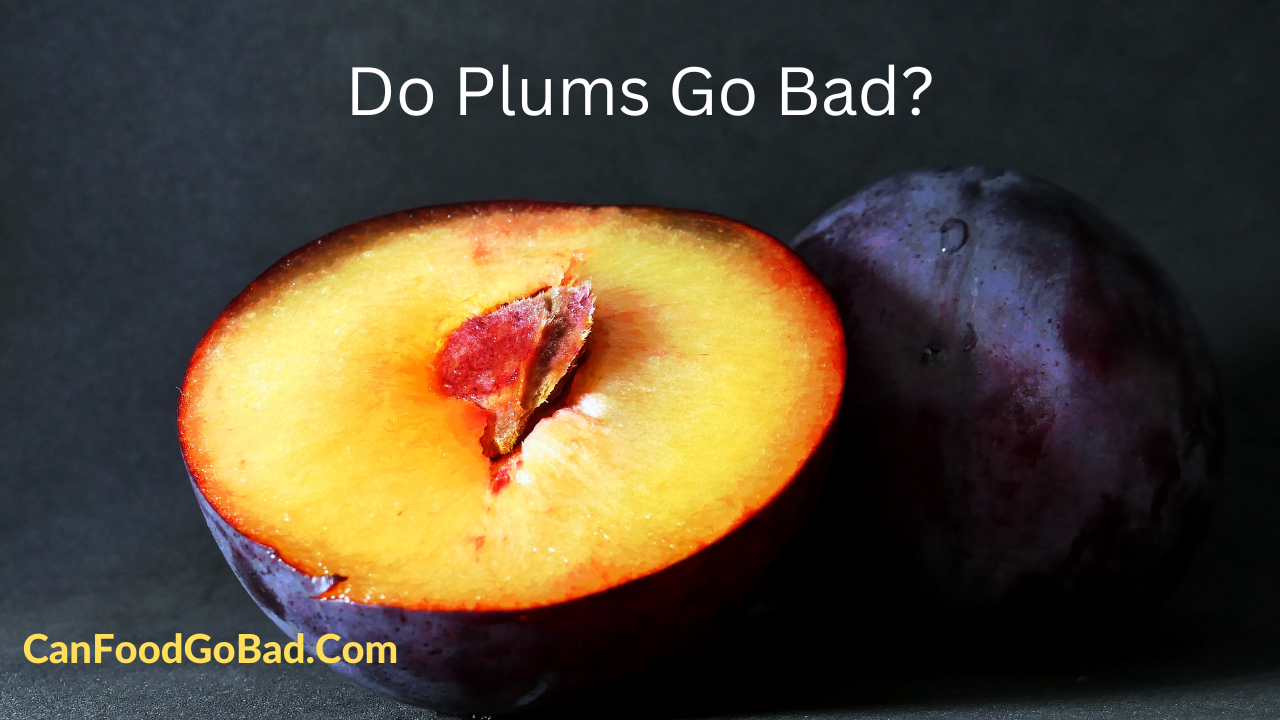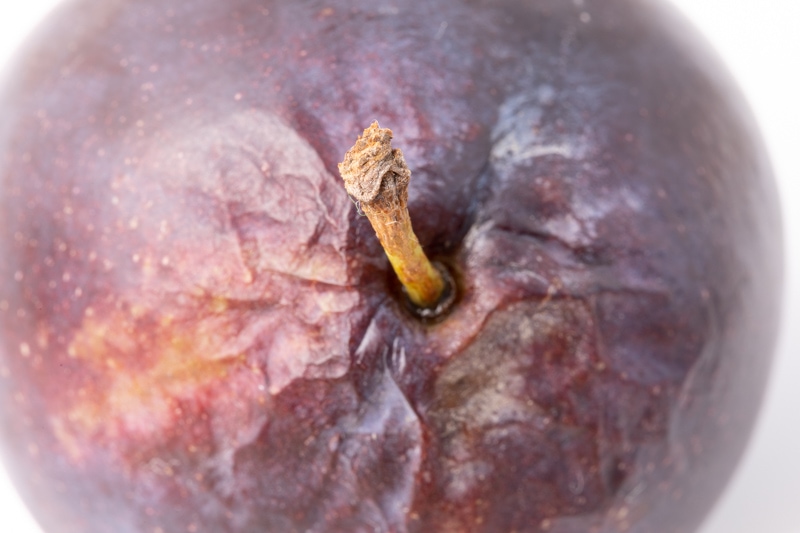Plums are one of summer’s most delicious fruits. With their sweet, tart flavor and dusty blue hue, fresh plums are a treat eaten out of hand or added to salads, desserts and more. However, like any fresh produce, plums have a limited shelf life. No one wants to bite into a plum only to find it bland, mushy or even rotten.
It’s important to know how to spot bad plums so you can get the most out of them and not waste them. This article covers everything you need to determine plum freshness. I’ll discuss:
- How long plums last
- Clear signs of spoiled plums
- Safe plum handling and storage
- What actually causes plums to spoil
Armed with this knowledge you’ll be able to enjoy plums at their peak ripeness and flavor. Let’s dive in!
How Long Do Plums Last?
Plums usually last between one and three weeks after being picked, but this depends on the type and how they are stored. Here are some general guidelines for plum shelf life:
- Unripe plums: 1-2 days on the counter to ripen
- Ripe plums: 2-5 days on the counter, 3-7 days in the fridge
- Frozen plums: 9-12 months in the freezer
Of course these timeframes can vary based on ripeness level storage conditions and handling. Later I’ll share tips to extend plum freshness.
How to Tell If Plums Have Gone Bad
Learning to identify signs of spoiled plums is key. Watch for these top indicators that plums have gone bad:
1. Mushy, Shriveled Texture
When pressed gently, a ripe, fresh plum should give a little but still feel firm. As plums go bad, their texture gets mushy and waterlogged, and their skin often gets dry and wrinkled.
Press lightly on the plum. If your thumb sinks in leaving an indentation, this signals overripeness. Avoid plums that are overly soft or collapsed as they’ll quickly decay.
2. Moldy Spots
When mold grows in small spots or a fuzzy layer forms, it means the food is going bad. Mold comes in different shades of white, green, and gray, and it means bacteria have taken hold.
Discard any plums with mold as the spores may have spread. For safety, keep moldy plums away from other produce.
3. Foul Odor
A ripe plum emits a sweet, floral scent. If you notice sour, fermented odors, this suggests spoilage. An “off” smell typically means the interior flesh is deteriorating.
Trust your nose when evaluating plums. Any rotten smell means they’ve spoiled.
4. Discolored or Sunken Skin
While ripe plums show some redness, avoid fruit with large brown or black soft spots. These mean the skin has broken down allowing bacteria inside.
In addition, a sunken, deflated look to the skin signals drying out. Plums with extensive discoloration or shriveling won’t last long.
5. Changes in Taste and Texture
Ultimately, biting into the plum is the best test. A ripe plum has sweetness and tartness with a soft crunch from the skin.
However, spoiled plums become dry and fibrous lacking juice. The taste also changes with rotten plums tasting flat, bitter or fermented.
If the taste or texture seem off, the plum is overripe. Don’t force yourself to eat bad fruit!
Proper Plum Handling
Mishandling plums during storage, transport and prep accelerates their decline. Follow these plum care tips:
-
Avoid bruising plums – handle gently without overcompressing.
-
Wash plums just before eating. Excess moisture grows mold.
-
Don’t refrigerate unripe plums. The cold halts ripening.
-
Once ripe, refrigerate plums to slow deterioration.
-
Store plums loose, not stacked which can crush them.
-
Keep plums away from ethylene-producing produce which hastens ripening.
With attentive handling, you can maintain plums at peak quality longer. Next let’s look at optimal storage methods.
How to Store Plums
Using the right techniques extends plum shelf life. Here are best practices for storing plums:
Room Temperature Storage
- Keep unripe plums at room temperature to ripen
- Place in a paper bag to concentrate ethylene and accelerate ripening
- Enjoy ripe plums within 2-3 days
Refrigerator Storage
- Place ripe plums loose in the crisper drawer
- Refrigeration preserves quality 3-7 days
- Wash just before eating to avoid mold
Freezer Storage
- Wash, dry, pit and slice plums before freezing
- Arrange slices in a single layer on a tray and freeze solid
- Transfer frozen slices to airtight containers
- Frozen plums last 9-12 months
Choosing suitable storage goes a long way towards making plums last. Next, we’ll explore what actually causes plums to spoil.
What Causes Plums to Spoil?
A few key factors lead to plum spoilage including:
-
Ripening – As plums ripen, their cell structures start deteriorating making them prone to bacteria.
-
Bruising – Any skin damage allows microbes to invade the flesh accelerating breakdown.
-
Temperature – Heat and cold extremes hasten plum deterioration. Refrigeration slows ripening and bacteria growth.
-
Ethylene exposure – This natural gas speeds up ripening in plums shortening shelf life.
-
Moisture – Wetness from washing or condensation encourages mold growth on the skin.
Knowing what makes plums perish allows us to take steps to prolong their freshness.
FAQs
Let’s wrap up with some frequently asked questions about plum longevity:
How can you ripen plums faster?
Place unripe plums in a paper bag at room temperature. The concentrated ethylene gas will accelerate ripening in 1-2 days.
What’s the best way to wash plums?
Rinse plums gently under cool water just before eating. Don’t soak or wash plums prior to storage as this encourages spoilage.
Can you freeze overripe plums?
Freezing preserves plums that are slightly overripe but not rotten. Prepare and freeze within 2 days of overripening for best quality.
How do you know if frozen plums are still good?
Inspect plums when thawing. Discard any with mold, odd odors or a mushy texture indicating spoilage during freezing.
Can spoiled plums make you sick?
While safe when fresh, rotten plums can harbor pathogens leading to illness if eaten. Always discard spoiled plums.
I hope these plum freshness tips help you reduce waste and enjoy plums at their best! Now you can store, handle, and identify bad plums with confidence.

How Long Do Plums Last?
| Pantry | Fridge | |
|---|---|---|
| Unripe plums | 2 to 3 days, until ripe | |
| Ripe plums | 2 – 3 days | 3 – 5 days |
Unripe plums usually need 1 to 2 days on the counter to ripen. Once ripe, plums keep for another 2 to 3 days at room temperature, or you can refrigerate them for 3 to 5 days, maybe even a week. If you need more time, you can freeze plums after pitting them.
Ripening plums typically takes 1 to 2 days, but if yours are still super firm after those two days, give them a bit more time. You can also speed up the ripening process, which I cover in the storage section.
Of course, all of those periods are only rough estimates.
If you buy soft plums on sale, they probably won’t stay good for more than a day or two. And it’s best to use those as soon as possible. Likewise, plums that are refrigerated at the peak of their freshness might keep for 7 to 10 days.
Last, if you leave ripe plums at room temperature, they deteriorate quickly and soften within a day or so. The same is true for other stone fruits, such as cherries (here’s how long cherries last) or peaches (How long do peaches last?).

Do Plums Need to Be Refrigerated?
No, but storing ripe plums in the fridge is highly recommended. Ripe plums left on the counter at room temperature keep for only 2 to 3 days, while refrigerated plums last up to a week. That’s a twofold increase in storage time, and that’s why refrigeration is the recommended storage method.
Under-ripe plums shouldn’t be refrigerated until they’re ripe, meaning they yield slightly under gentle pressure. If refrigerated, they’ll stay firm and won’t fully develop their flavor.
